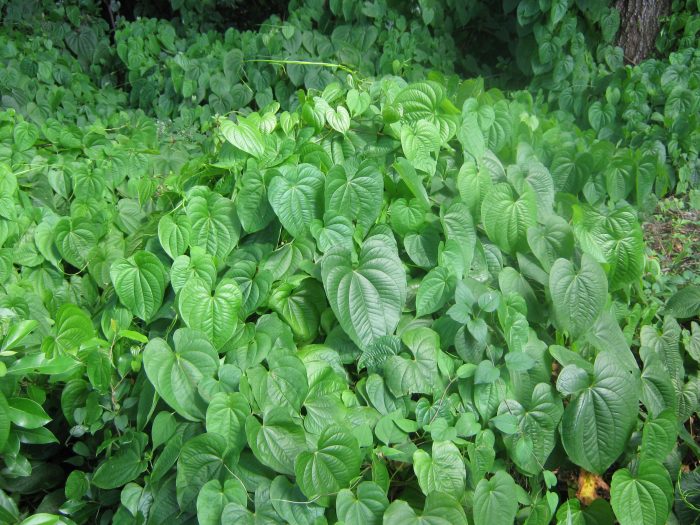Over the years we’ve developed a real specialty for exotic plant control, slowly restoring Florida to its natural vegetative state by methodically removing invasive species from Florida’s land and waterways. We’ve physically and chemically removed everything in the invasive species index, from alligator weed to wild taro. So, you can imagine our delight in leveraging one of nature’s great rivalries, Dioscorea bulbifera (air potato) vs.Lilioceris cheni (air potato beetle), to help us on our mission of restoration.
Meet The Air Potato
Air potato, Dioscorea bulbifera, a species of true yam, “was introduced to Florida in 1905 when it was sent to the USDA by Henry Nehrling, who later noted its invasive potential (Morton 1976). It has since become extremely aggressive (Hammer 1998). By the 1980s, air potato vines were growing in thickets, waste areas, and hedges or fencerows in many parts of south and central Florida (Bell and Taylor 1982). By 1999, air potato was recognized as an invasive exotic that alters plant communities by displacing native species, changing community structure, and disrupting ecological functions (FLEPPC 2003).” – Ted D. Center and William A. Overholt
Really? How Bad Could It Be?
Air potato, the “bully” vine that will outgrow almost everything, is described and hilariously confronted by Stephen Brown, Lee County Extension Service:
Enter The APB
The solution to this native plant choking menace? Meet The Mighty Air Potato Beetle (APB), Lilioceris cheni, Nature’s cure for air potato – a little leaf feeding beetle, a specialist consumer of air potato, Lilioceris cheni, recently introduced into Florida from China for biological control of air potato. This little 9mm long and 4mm wide critter, native to Asia and has been recorded in India, Nepal, Laos and Thailand was first released in Florida in 2012 for biological control of air potato.

Adult air potato beetle, Lilioceris cheni
In the wise words of Yoda: “Size matters not.”
And judge the Air Potato Beetle by it’s tiny stature you should not. This little green-leaf-eating insect, a natural specialist feeder on air potato, packs quite the punch in its 5 month adult lifespan. The “Air Potato Beetle,” from larvae stage through adulthood, earns its suggested common name by consuming massive quantities of leaf tissue and occasionally feed on bulbils — negatively affecting air potato plant growth and reproduction.
At initial release sites, extensive damage to air potato was evident within three months after the first release. “Although it is too early to determine the long-term impacts of the beetle on air potato, initial results are very promising.” – Ted D. Center and William A. Overholt
AAM’s experience with the beetle?
We released somewhere around 50 beetles into a natural pinewoods/wetland area at AAM headquarters, where the infestation of Air Potato covered the ground and was climbing trees 8 to 10 ft. The beetles clocked in and began work on time, consuming air potato with a vigorous appetite that would rival Joey Chestnut. Not bad for a free program from University of Florida and IFAS (Institute of Food and Science).
Spot this little guy taking down Air Potato in your neck of the woods?
Email us a picture. We’d love to hear from you. How to recognize the beetle? Here’s what to look for:
Adults: The adults of the air potato beetle are about 3/8 inch long and 3/16 inch wide. The wings are red, and the abdomen, thorax, head, and legs are black. The body shape somewhat resembles a square violin with a short neck.
Eggs: Eggs are white and laid in groups on the underside of leaves. They are 1/32 inch long and hatch after four days.
Larvae: Early instars are yellowish to reddish, and later instars are grayish to reddish. Larvae are often covered with a sticky secretion to which fecal material adheres.
Interested in hiring AAM to wrangle invasive species in your neck of the woods? Learn more about our exotic plant control services:
Article references:
- University of Florida IFAS Exension: Air Potato Leaf Beetle (PDF)
- Hayslip Biological Control Research and Containment Laboratory: Meet the Air Potato Leaf Beetle
- University of Florida IFAS: Featured Creatures
- Wikipedia:Dioscorea bulbifera
- Wikipedia: Lilioceris cheni





